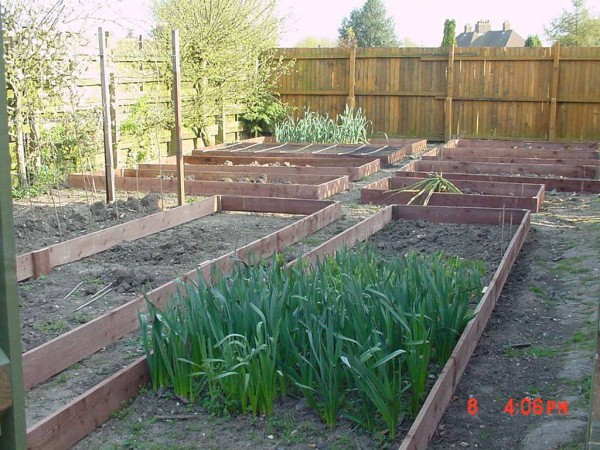Raised beds
From Allotments4All
Preparing raised beds
Raised bed, sometimes referred to as lazy bed, describes a method of dividing ground between narrow strips designated for cultivation and bordered by permanant fixed paths.
Most are no wider than 4ft so you can reach to the middle and can work the bed without walking on the soil. They can be any length but the longer they are the further you will have to go to tend to crops on the other side.
New paths need to be built wide enough to provide practical working space when tending crops and you may want to consider ensuring there is an access path wide enough for a wheel barrow bordering at least one long side of each raised bed you mark out.
Borders to beds may be built with timber, with plastic sheeting coating the inside face to keep the timber dry and prolong its life. Beds do not require wooden edgeing but this option is choosen to prevent material creeping onto fixed paths as the beds gain in height. If you choose not to have wooden edging boards (perhaps because your soil is particularly prone to slugs, you can also simply outline the edges of the bed with string and pegs.
Most gardeners find that raised beds are easier to maintain and promote better plant growth. Walking in a garden causes soil compaction, which can cause problems with drainage and oxygen availability to the roots. It's also more difficult to weed when soil is compacted. With a raised bed, you can plant, weed and harvest without ever walking on the soil.
Raised beds can be filled with high-quality soil and it's easy to add compost or other organic matter. Long-rooted plants, such as carrots, do especially well in this environment, because there are no stones to hinder their development.
Plants in raised beds get more sun and air circulation and they can make better use of water, though critics would say that they can be more inclined to drought.
One solution to this is to dig a series of holes, remove the bottoms and tops form 2 ltr plastic bottles then bury them upside down. When the soil becomes dry you simply fill the bottles with water, which then fans out across the lower levels of the bed.
You often can plant earlier and harvest later, because raised beds warm up early in the spring and stay warm later in the fall.
Raised beds also make ideal places to grow plants that can be invasive in a regular garden – such as mints and horseradish. But ease and convenience is the benefit many gardeners appreciate the most. If you get a bad back and sore knees every year from gardening, a raised bed may put an end to those aches and pains.
Raised vegetable beds are excellent for gardeners who have trouble with their backs and older people who don't have limited flexibility. They are also excellent for people in wheelchairs or with other disabilities and those who don't want to spend the summer on their knees in the garden.
To install a raised bed, first choose a sunny location and decide on the size and shape you want. Some gardeners till the soil before building raised beds, to provide additional room for root development.
Building a raised bed
Construct the frame with a nontoxic building material, such as stone, cinder blocks, bricks, untreated wood or fiberglass. Some garden catalogs and centers now offer raised bed frames that snap together and can easily be taken apart.
Make sure the frame is between 12 and 16 inches high and is sturdy enough to hold together when filled with soil. If you use boards, they must be secured at the corners with metal braces or screws, or nailed to a reinforcing block of wood inside the corners – if you nail into the ends of boards, they will split.
Fill the frame with a good-quality lightweight soil mix and add a generous amount of compost. Avoid using soil straight from the garden. It usually is too heavy and doesn't allow for proper drainage.
A well-constructed raised bed should last for years and soil fertility can be maintained by adding organic matter. Raised beds have been used for centuries and with good reason – they're better for many plants and they're easier on gardeners.
Source: Penn State, Agricultural Information Services

